How to prepare sushi at home
 Bashny.Net
Bashny.Net
Very much I love sushi. It is true he did not cook usually prefer to eat in restaurants. Prepare sushi at home is not as difficult as it might seem at first glance. It does not matter that the first time it will not turn too beautiful. They are less tasty from it will not :) Over time, you will gain the necessary skills and be able to make sushi easily and effortlessly. On average, the cooking process takes an hour and a half. The main types of sushi: 1. Nigiri (sushi compressed): small, compressed rice sticks the size of a finger with a piece of fish on top. Sushi bars are usually served in pairs. 2. Maki (rolls): rice with any combination of seafood and vegetables, rolled up in a sheet of nori seaweed. Subsequently, the roll is cut into pieces. 3. Chirashi-sushi (sushi separate): The most common kind in Japan. Figure decomposed into small containers, and crowned with any combination of seafood and vegetables. 4. Oshi Sushi (pressed sushi): cooked or pickled fish is placed on the bottom of a small container which is then filled to the brim with rice. On top of the rice put oppression. After some time, the workpiece is removed, inverted and the fish is cut up into pieces. 5. Mixed sushi: any others, were not included in the above categories. For example, fukuza sushi - a thin omelet squares used to wrap rice. Today we will learn to prepare two types of sushi: nigiri and maki.
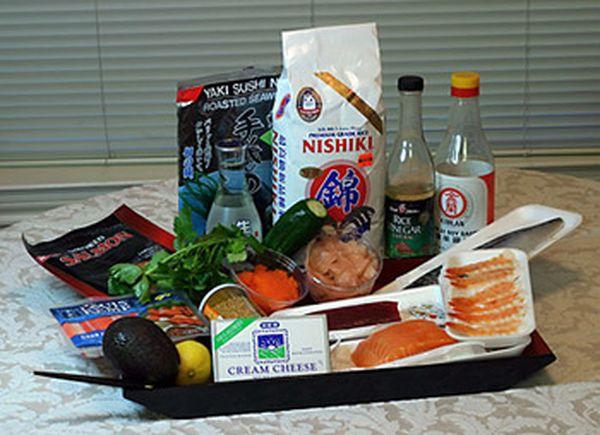
Necessary products
1. Rice for sushi (with short, rounded grains)

1. Rice for sushi (with short, rounded grains)
& Quot; title = «Ingredients
1. Rice for sushi (with short, rounded grains)
»& Gt;
Some foods closeup:

& Quot; title = «Some foods closeup:
»& Gt;
Rice vinegar (su). It is highly desirable to use Japanese rice vinegar, mild and sweet. Chinese and especially Western brands stronger and more acidic, and can clog your scent delicate flavor of sushi. Rice vinegar Mitsukan most suitable, sold in many Asian stores.

Nori (seaweed). Usually sold in packs of 5-10 pieces, and is a dark, crisp sheets, 20 x 18 cm. They are used in the preparation of maki (rolls). In color are dark green and almost black. Those that black - more expensive, but with a stronger aroma.

Raw fresh fish: salmon (sake) and tuna (maguro). Fish in no case should never be frozen! It is advisable to buy specially designed for sushi in Japanese stores, marked «sushi grade».
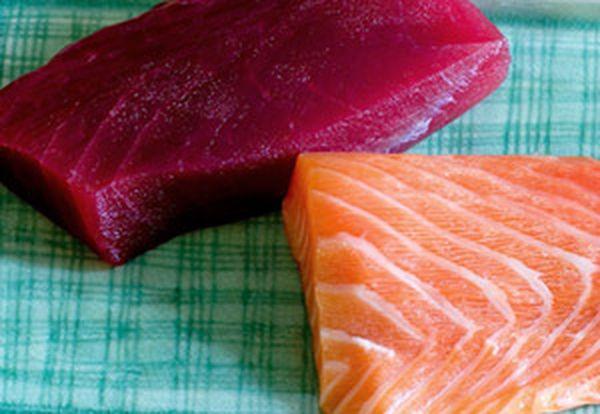
Flying fish roe (Masago). Random component. It is mainly used for decoration on top of rolls or obvalivaniya them outside, when preparing rice rolls out (hooray-maki).
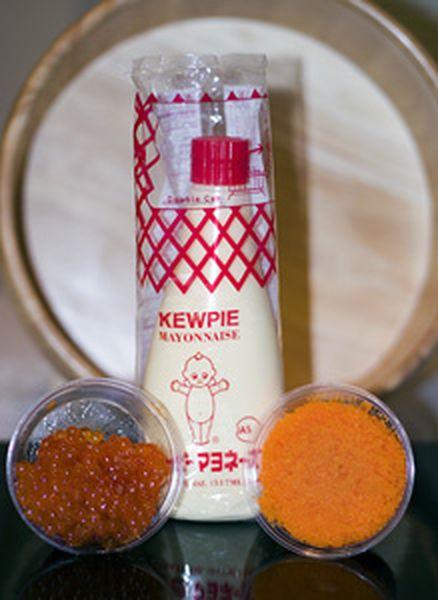
Filling for rolls, arbitrary combination. For example, crab sticks, strips of avocado, cucumber and cream cheese. Additionally, you can use a special Japanese mayonnaise (regular too sharp).

Preparation of rice for sushi
Rice, not the fish - the most important ingredient in sushi. That matter is properly prepared it depends taste of the dish. We need rice in Japanese style, with short rounded grains. Typically, the length is not suitable, it is very dry, and therefore retains too much water. Recommended varieties: Nishiki, Kahomai, Maruyu, Kokuho and Minori.

Rice, not the fish - the most important ingredient in sushi. That matter is properly prepared it depends taste of the dish. We need rice in Japanese style, with short rounded grains. Typically, the length is not suitable, it is very dry, and therefore retains too much water. Recommended varieties: Nishiki, Kahomai, Maruyu, Kokuho and Minori. & Quot; title = «Cooking sushi rice
Rice, not the fish - the most important ingredient in sushi. That matter is properly prepared it depends taste of the dish. We need rice in Japanese style, with short rounded grains. Typically, the length is not suitable, it is very dry, and therefore retains too much water. Recommended varieties: Nishiki, Kahomai, Maruyu, Kokuho and Minori. »& Gt;
1. Washing the rice. As a rule, for two people is enough to take one cup of rice. But given the fact that you get the hang of the process of eating his own sushi, better start from the calculation of the two cups.
2. Drain almost all the water. Stir again and pressing his hand figure already firmly but smoothly, without breaking, for 10 seconds. Pour fresh water, wring out and drain. Repeat one or two times, the water should be almost transparent. Drain.

2. Drain almost all the water. Stir again and pressing his hand figure already firmly but smoothly, without breaking, for 10 seconds. Pour fresh water, wring out and drain. Repeat one or two times, the water should be almost transparent. Drain. & Quot; title = «1. Washing the rice. As a rule, for two people is enough to take one cup of rice. But given the fact that you get the hang of the process of eating his own sushi, better start from the calculation of the two cups.
2. Drain almost all the water. Stir again and pressing his hand figure already firmly but smoothly, without breaking, for 10 seconds. Pour fresh water, wring out and drain. Repeat one or two times, the water should be almost transparent. Drain. »& Gt;
3. Cooking rice. Put the washed rice in a deep pan. For each cup of rice add 250 mL of cold water (in this case 500 ml). Close the lid, put the maximum heat and bring to a boil quickly (takes about 5-7 minutes). Then, heat set at a minimum value, and leave for 12 minutes. After this time, the water is completely absorbed by the rice, and on its surface there was a small ventilation holes. Without removing the lid, remove the pan from the heat and let stand another 15 minutes.
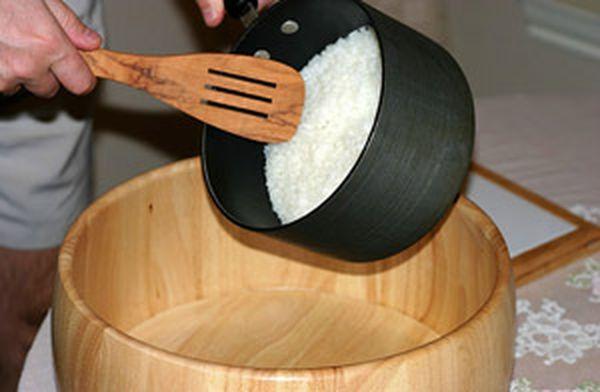
4. While the rice insists prepare dressing for him. Two cups of rice will need a 50ml rice vinegar, 30 g of sugar and 10 g of salt. Dissolve sugar in vinegar and salt. You can pre-heat it slightly (very slightly!).
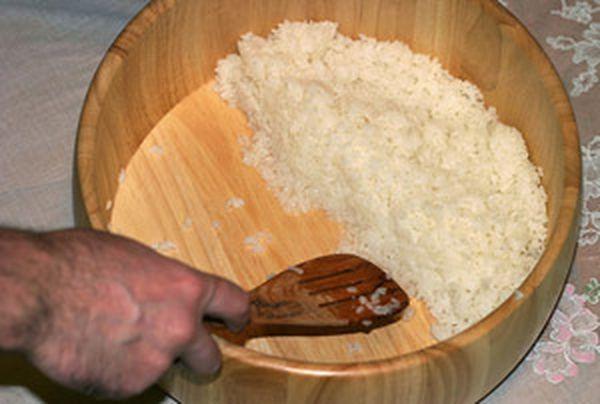
Nigiri
br & gt; While the rice cools down, we need to cut the fish. For different types of sushi, there are 5 different techniques slicing. But for the most suitable technique nigiri cutting fish "angle».
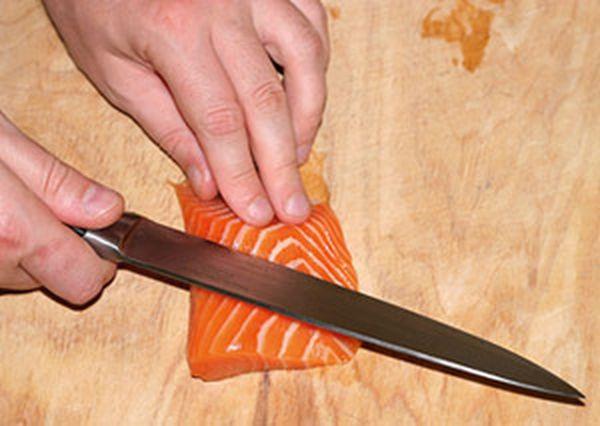
br & gt; While the rice cools down, we need to cut the fish. For different types of sushi, there are 5 different techniques slicing. But for the most suitable technique nigiri cutting fish & quot; & gt; br & gt; While the rice cools down, we need to cut the fish. For different types of sushi, there are 5 different techniques slicing. But for the most suitable technique nigiri cutting fish "angle». & Quot; & gt;
It is advisable to take fish harvesting rectangular shape, about 10 cm long and 2, 5 high.
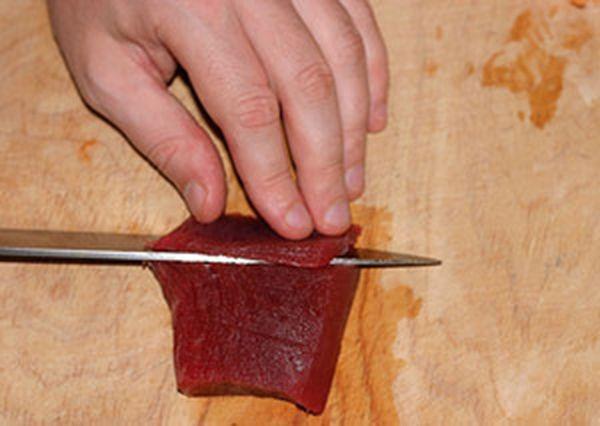
Form the nigiri. By this time, the rice is to cool down, or to be barely warm. Prepare a small bowl with wasabi and acetic water (tezu) to wet hands (just pour boiling water in a bowl with a less wide neck, and add a couple of tablespoons rice vinegar). When forming nigiri hands should always be wet, otherwise it will not work.
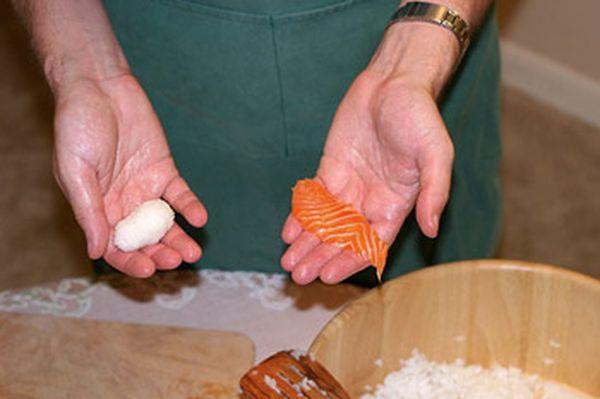
Carefully turn the nigiri, to bring it to the tips of the fingers of his left hand up fish. Now move it to the base of the fingers while gripping the ends. Press the denser fish to rice.

Right index finger scoop a little wasabi (not letting rice harvesting of palm), and slightly promazhte piece of fish. Put the rice on top. Left thumb gently press the rice on top, leaving almost invisible vmyatinku. Now change hands, and push more strongly on the entire surface of the rice index and middle fingers of the right hand.

Nigiri ready! Over time, you learn how to do them quickly and correctly. Make sure that the rice was "pinched" and that Sliced has always been more rice harvesting, and how to close it.

Rolls (maki)
Rolls - "twisted land" - are formed using a bamboo mat (Macy's). Filling can be any, according to your wishes. Usually it any seafood in combination with vegetables (avocado, cucumber), unsharp Japanese mayonnaise or cream cheese. With mat rice stuffed rolled into a sheet of nori seaweed.
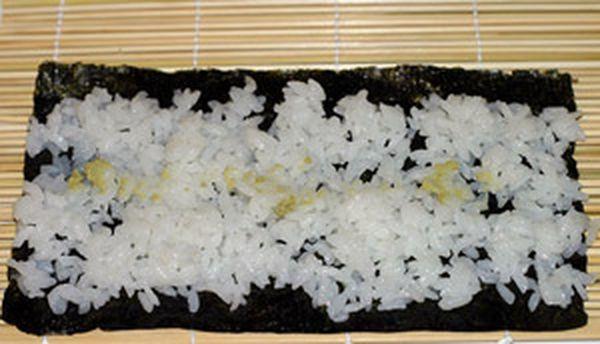
Rolls - & quot; & gt;
Rolls - "twisted land" - are formed using a bamboo mat (Macy's). Filling can be any, according to your wishes. Usually it any seafood in combination with vegetables (avocado, cucumber), unsharp Japanese mayonnaise or cream cheese. With mat rice stuffed rolled into a sheet of nori seaweed. & Quot; & gt;
1. Thin rolls (Hoso-maki). Thin rolls, diameter of about 2, 5 cm, usually contain only one component. To make them you need half sheet algae (fold the paper in half and cut with scissors). Of this half got 6 pieces of sushi.

For fish rolls should be cut into narrow strips just, or use leftovers from cutting nigiri. Put half of the algae on the mat with the shiny side down. Wet your hands with acetic water. Take about 4 tablespoons of rice with a slide and spread it over the surface of the algae. With the upper edge, leave a free strip of about 1 cm from the bottom - about 0, 5 cm. The height of the rice layer should be about 7 mm. Take your time, evenly distribute rice, constantly wetting the hands. Forefinger promazhte wasabi strip along the entire length of rice in the middle. Top with toppings such as sliced tuna.
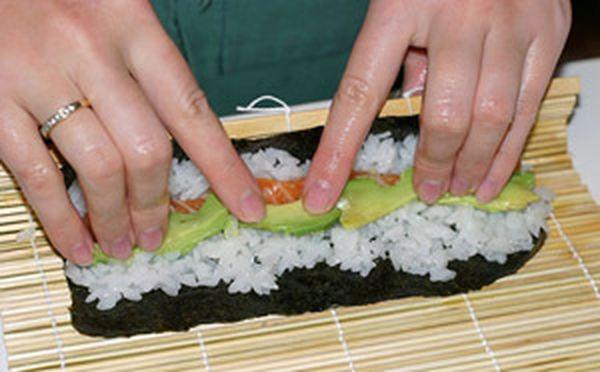
Align the bottom edge of the seaweed with the edge of a bamboo mat. Now, by holding the filling in place, lift the edge of the mat using the thumbs, as shown in pictures above. Continue to raise the mat up and forward until it stops against the edge of the opposite side algae. Fold the top edge of the mat, roll it roll back and forth a bit and squeeze it inside the mat. Press the ends of the roll fingers if there fell Fig. Put roll to the side on a smooth surface, and start making the next.

2. Thick rolls (maki-ft). Thick rolls, diameter 5 cm, can contain up to five components. To make them take a sheet of seaweed, put on the mat with the shiny side down. Wet your hands with water and acetic evenly rice seaweed, leaving the top side free about 2 cm. On request, promazhte Figure unsharp mayonnaise.

Hold all the ingredients, lift the edge of the mat with your thumbs and continue to raise it up and forward until the edge of the mat touches the opposite edge of the algae. Then, fold the edge of the carpet upstairs, and "roll" roll forward. Gently squeeze it inside the mat, press down with your fingers on the ends if dropped Fig. Put on a smooth surface, and start making the next.

3. How to cut the rolls. Take a sharp knife and dip the tip into acetic water. Then, turn it points upwards, so that water ran across the surface of the blade and evenly moistened it. This will allow the blade to easily pass through the sticky rice and not get stuck in it.
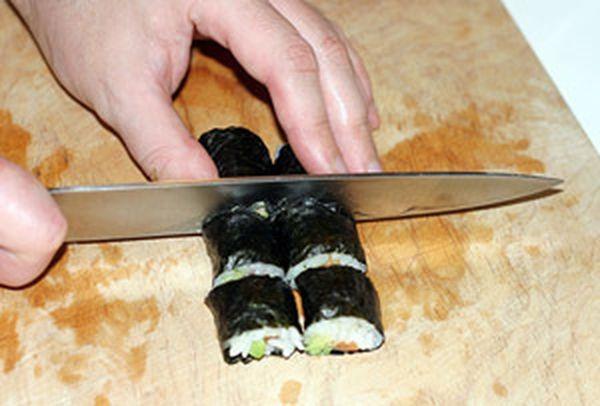
As a result, you should get about the same as shown in the photo. In the manufacture of rolls, especially foot-maki, you need to make sure that did not turn in "snail" of algae. These rolls are not considered conditionally, and show that manufactures violated principles of coagulation rolls, and yet not quite mastered the art of making sushi rolls :) Inside there should be nothing but rice with ingredients (as in roll in the lower right corner of the photo).

Spread the beautiful sushi trays, pour into a ceramic cup soy sauce. It can dissolve a little wasabi, if you want more thrills. You can also add to the sauce and pickled ginger leaf, but it is traditionally used to cleanse the palate the taste of the previous piece of land. Capturing sushi with chopsticks, dipped it in the sauce, allow to soak a few seconds and placed in the mouth.
Bon Appetite!
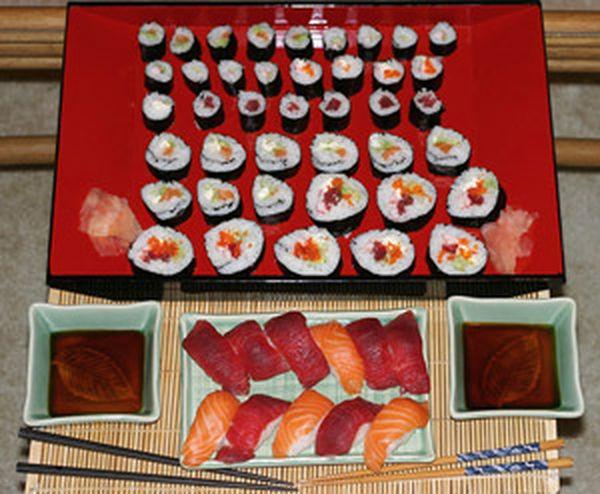
Bon Appetite! & Quot; title = «Spread sushi on beautiful trays, pour into a ceramic cup soy sauce. It can dissolve a little wasabi, if you want more thrills. You can also add to the sauce and pickled ginger leaf, but it is traditionally used to cleanse the palate the taste of the previous piece of land. Capturing sushi with chopsticks, dipped it in the sauce, allow to soak a few seconds and placed in the mouth.
Bon Appetite! "& Gt;
via mojbred.com

Necessary products
1. Rice for sushi (with short, rounded grains)

1. Rice for sushi (with short, rounded grains)
& Quot; title = «Ingredients
1. Rice for sushi (with short, rounded grains)
»& Gt;
Some foods closeup:

& Quot; title = «Some foods closeup:
»& Gt;
Rice vinegar (su). It is highly desirable to use Japanese rice vinegar, mild and sweet. Chinese and especially Western brands stronger and more acidic, and can clog your scent delicate flavor of sushi. Rice vinegar Mitsukan most suitable, sold in many Asian stores.

Nori (seaweed). Usually sold in packs of 5-10 pieces, and is a dark, crisp sheets, 20 x 18 cm. They are used in the preparation of maki (rolls). In color are dark green and almost black. Those that black - more expensive, but with a stronger aroma.

Raw fresh fish: salmon (sake) and tuna (maguro). Fish in no case should never be frozen! It is advisable to buy specially designed for sushi in Japanese stores, marked «sushi grade».

Flying fish roe (Masago). Random component. It is mainly used for decoration on top of rolls or obvalivaniya them outside, when preparing rice rolls out (hooray-maki).

Filling for rolls, arbitrary combination. For example, crab sticks, strips of avocado, cucumber and cream cheese. Additionally, you can use a special Japanese mayonnaise (regular too sharp).

Preparation of rice for sushi
Rice, not the fish - the most important ingredient in sushi. That matter is properly prepared it depends taste of the dish. We need rice in Japanese style, with short rounded grains. Typically, the length is not suitable, it is very dry, and therefore retains too much water. Recommended varieties: Nishiki, Kahomai, Maruyu, Kokuho and Minori.

Rice, not the fish - the most important ingredient in sushi. That matter is properly prepared it depends taste of the dish. We need rice in Japanese style, with short rounded grains. Typically, the length is not suitable, it is very dry, and therefore retains too much water. Recommended varieties: Nishiki, Kahomai, Maruyu, Kokuho and Minori. & Quot; title = «Cooking sushi rice
Rice, not the fish - the most important ingredient in sushi. That matter is properly prepared it depends taste of the dish. We need rice in Japanese style, with short rounded grains. Typically, the length is not suitable, it is very dry, and therefore retains too much water. Recommended varieties: Nishiki, Kahomai, Maruyu, Kokuho and Minori. »& Gt;
1. Washing the rice. As a rule, for two people is enough to take one cup of rice. But given the fact that you get the hang of the process of eating his own sushi, better start from the calculation of the two cups.
2. Drain almost all the water. Stir again and pressing his hand figure already firmly but smoothly, without breaking, for 10 seconds. Pour fresh water, wring out and drain. Repeat one or two times, the water should be almost transparent. Drain.

2. Drain almost all the water. Stir again and pressing his hand figure already firmly but smoothly, without breaking, for 10 seconds. Pour fresh water, wring out and drain. Repeat one or two times, the water should be almost transparent. Drain. & Quot; title = «1. Washing the rice. As a rule, for two people is enough to take one cup of rice. But given the fact that you get the hang of the process of eating his own sushi, better start from the calculation of the two cups.
2. Drain almost all the water. Stir again and pressing his hand figure already firmly but smoothly, without breaking, for 10 seconds. Pour fresh water, wring out and drain. Repeat one or two times, the water should be almost transparent. Drain. »& Gt;
3. Cooking rice. Put the washed rice in a deep pan. For each cup of rice add 250 mL of cold water (in this case 500 ml). Close the lid, put the maximum heat and bring to a boil quickly (takes about 5-7 minutes). Then, heat set at a minimum value, and leave for 12 minutes. After this time, the water is completely absorbed by the rice, and on its surface there was a small ventilation holes. Without removing the lid, remove the pan from the heat and let stand another 15 minutes.

4. While the rice insists prepare dressing for him. Two cups of rice will need a 50ml rice vinegar, 30 g of sugar and 10 g of salt. Dissolve sugar in vinegar and salt. You can pre-heat it slightly (very slightly!).

Nigiri
br & gt; While the rice cools down, we need to cut the fish. For different types of sushi, there are 5 different techniques slicing. But for the most suitable technique nigiri cutting fish "angle».

br & gt; While the rice cools down, we need to cut the fish. For different types of sushi, there are 5 different techniques slicing. But for the most suitable technique nigiri cutting fish & quot; & gt; br & gt; While the rice cools down, we need to cut the fish. For different types of sushi, there are 5 different techniques slicing. But for the most suitable technique nigiri cutting fish "angle». & Quot; & gt;
It is advisable to take fish harvesting rectangular shape, about 10 cm long and 2, 5 high.

Form the nigiri. By this time, the rice is to cool down, or to be barely warm. Prepare a small bowl with wasabi and acetic water (tezu) to wet hands (just pour boiling water in a bowl with a less wide neck, and add a couple of tablespoons rice vinegar). When forming nigiri hands should always be wet, otherwise it will not work.

Carefully turn the nigiri, to bring it to the tips of the fingers of his left hand up fish. Now move it to the base of the fingers while gripping the ends. Press the denser fish to rice.

Right index finger scoop a little wasabi (not letting rice harvesting of palm), and slightly promazhte piece of fish. Put the rice on top. Left thumb gently press the rice on top, leaving almost invisible vmyatinku. Now change hands, and push more strongly on the entire surface of the rice index and middle fingers of the right hand.

Nigiri ready! Over time, you learn how to do them quickly and correctly. Make sure that the rice was "pinched" and that Sliced has always been more rice harvesting, and how to close it.

Rolls (maki)
Rolls - "twisted land" - are formed using a bamboo mat (Macy's). Filling can be any, according to your wishes. Usually it any seafood in combination with vegetables (avocado, cucumber), unsharp Japanese mayonnaise or cream cheese. With mat rice stuffed rolled into a sheet of nori seaweed.

Rolls - & quot; & gt;
Rolls - "twisted land" - are formed using a bamboo mat (Macy's). Filling can be any, according to your wishes. Usually it any seafood in combination with vegetables (avocado, cucumber), unsharp Japanese mayonnaise or cream cheese. With mat rice stuffed rolled into a sheet of nori seaweed. & Quot; & gt;
1. Thin rolls (Hoso-maki). Thin rolls, diameter of about 2, 5 cm, usually contain only one component. To make them you need half sheet algae (fold the paper in half and cut with scissors). Of this half got 6 pieces of sushi.

For fish rolls should be cut into narrow strips just, or use leftovers from cutting nigiri. Put half of the algae on the mat with the shiny side down. Wet your hands with acetic water. Take about 4 tablespoons of rice with a slide and spread it over the surface of the algae. With the upper edge, leave a free strip of about 1 cm from the bottom - about 0, 5 cm. The height of the rice layer should be about 7 mm. Take your time, evenly distribute rice, constantly wetting the hands. Forefinger promazhte wasabi strip along the entire length of rice in the middle. Top with toppings such as sliced tuna.

Align the bottom edge of the seaweed with the edge of a bamboo mat. Now, by holding the filling in place, lift the edge of the mat using the thumbs, as shown in pictures above. Continue to raise the mat up and forward until it stops against the edge of the opposite side algae. Fold the top edge of the mat, roll it roll back and forth a bit and squeeze it inside the mat. Press the ends of the roll fingers if there fell Fig. Put roll to the side on a smooth surface, and start making the next.

2. Thick rolls (maki-ft). Thick rolls, diameter 5 cm, can contain up to five components. To make them take a sheet of seaweed, put on the mat with the shiny side down. Wet your hands with water and acetic evenly rice seaweed, leaving the top side free about 2 cm. On request, promazhte Figure unsharp mayonnaise.

Hold all the ingredients, lift the edge of the mat with your thumbs and continue to raise it up and forward until the edge of the mat touches the opposite edge of the algae. Then, fold the edge of the carpet upstairs, and "roll" roll forward. Gently squeeze it inside the mat, press down with your fingers on the ends if dropped Fig. Put on a smooth surface, and start making the next.

3. How to cut the rolls. Take a sharp knife and dip the tip into acetic water. Then, turn it points upwards, so that water ran across the surface of the blade and evenly moistened it. This will allow the blade to easily pass through the sticky rice and not get stuck in it.

As a result, you should get about the same as shown in the photo. In the manufacture of rolls, especially foot-maki, you need to make sure that did not turn in "snail" of algae. These rolls are not considered conditionally, and show that manufactures violated principles of coagulation rolls, and yet not quite mastered the art of making sushi rolls :) Inside there should be nothing but rice with ingredients (as in roll in the lower right corner of the photo).

Spread the beautiful sushi trays, pour into a ceramic cup soy sauce. It can dissolve a little wasabi, if you want more thrills. You can also add to the sauce and pickled ginger leaf, but it is traditionally used to cleanse the palate the taste of the previous piece of land. Capturing sushi with chopsticks, dipped it in the sauce, allow to soak a few seconds and placed in the mouth.
Bon Appetite!

Bon Appetite! & Quot; title = «Spread sushi on beautiful trays, pour into a ceramic cup soy sauce. It can dissolve a little wasabi, if you want more thrills. You can also add to the sauce and pickled ginger leaf, but it is traditionally used to cleanse the palate the taste of the previous piece of land. Capturing sushi with chopsticks, dipped it in the sauce, allow to soak a few seconds and placed in the mouth.
Bon Appetite! "& Gt;
via mojbred.com
Tags
See also
How to cook the Marseille Bouillabaisse soup
How to cook the Marseille Bouillabaisse soup
How to make amazing potato gnocchi
How to cook vegetable beetroot soup
How and what to feed homemade rat
How to cook classic Indian kichri
How to make beet salad at the Georgian
How to cook gratin of zucchini
How to cook couscous with carrots and chickpeas

















